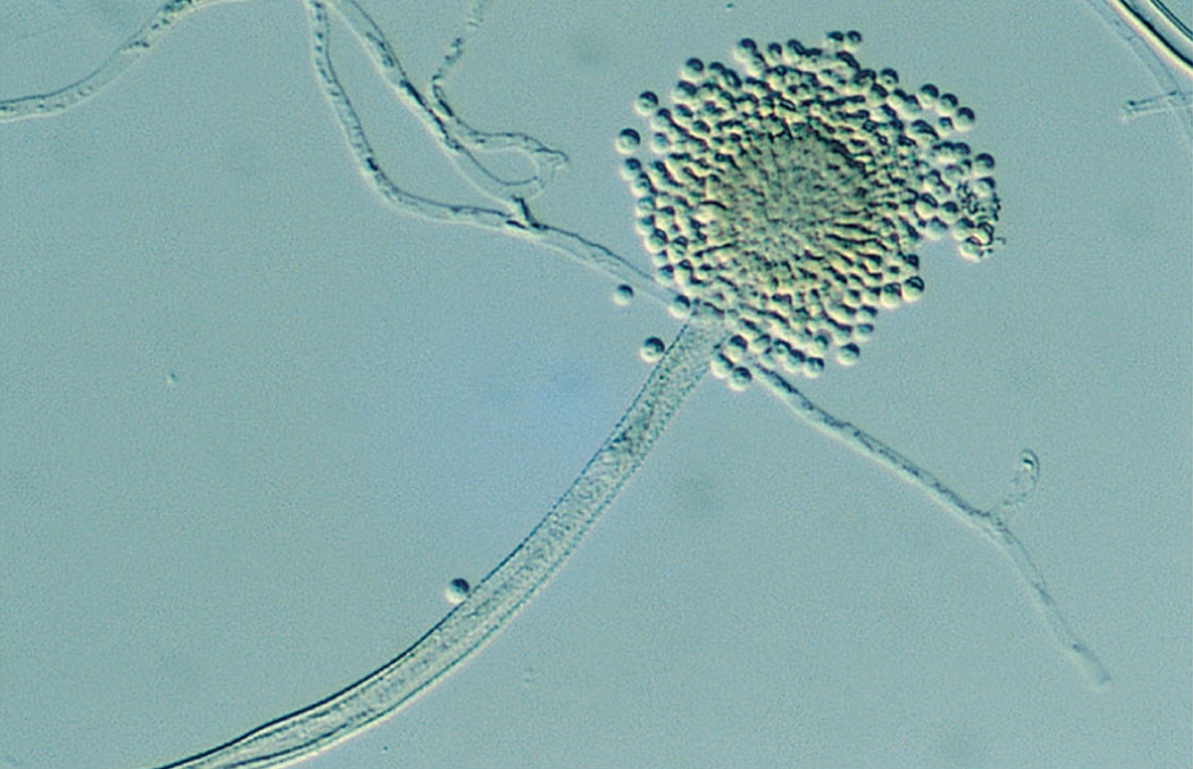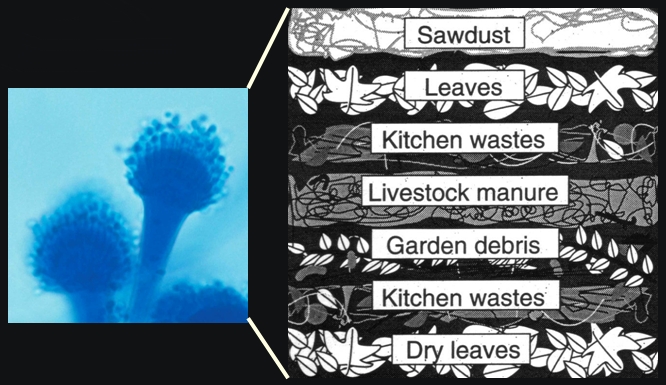Aspergillus fumigatusOverview: Aspergillus fumigatus is a highly prevalent airborne fungus that causes the disease aspergillosis (Figure 1). It is a filamentous saprophytic fungus that grows in multicellular filaments called hyphae by feeding on dead or decaying organic matter. A. fumigatus is most commonly found in soil, feeding on waste substrates to obtain nutrients and energy via biodegradation. Biodegradation naturally helps the ecosystem recycle dead organisms or waste as a means to help continue the cycle of life and replenish the soil and environment with carbon and nitrogen. Typically, A. fumigatus secrete hydrolytic enzymes from hyphal tips that help cleave starches, hemicelluloses, cellulose, and other sugar polymers the body cannot digest. This organism is also thermotolerant; it has the ability to thrive at greater than 37°C, thereby increasing its germination efficiency and growth rate. Figure 1. This photomicrograph depicts the appearance of a conidiophore (stalk) of the fungus Aspergillus fumigatus. Although A. fumigatus fungi primarily feed on decaying vegetation, they can also dine on substrates as diverse as dung, human tissues, and antique parchment. Moulds produced by this pathogen are capable of degrading manmade substrates such as textiles and paper in a process known as biodeterioration. Nuts, spices, and grains that are low in water are the most attractive foods to be spoiled by A. fumigatus. A. fumigates morphology varies depending on the amount of oxygen and the temperature and humidity available. Characteristically, this species can reproduce asexually by producing airborne spores (conidia) and sexually as well. They are also able to thrive in harsh conditions and in extreme temperatures, and thus are categorized as opportunistic pathogens. A. fumigatus fungi are commonly isolated from soil, plant debris, indoor air environments and other such oxygenated areas, where they are constantly undergoing aerobic decomposition (Figure 2). Environmental surveys indicate that in areas of human habitation, approximately 1 to100 A. fumigatus conidia are typically found per cubic metre of air, and thus all humans inhale at least several hundred conidia per day. Hence, they are part of the normal flora in humans, where they exist in the mucous membranes of the upper respiratory tract. These conidia, however, are beneficial in that they compete with other, potentially more dangerous microorganisms that can essentially harm the host. Infections arise when conidia enter the lungs, germinate on lung alveoli, and produce mycelium which penetrates lung tissue. Figure 2. Nutritional versatility of Aspergillus fumigatus. Click to enlarge. Clinical Infections: As mentioned earlier, aspergillosis is the prominent illness caused by A. fumigatus. There are many different kinds of aspergillosis. One kind is allergic bronchopulmonary aspergillosis, a condition where the fungus causes allergic respiratory symptoms, such as wheezing and coughing, but does not actually invade and destroy tissue. Another kind of aspergillosis is invasive aspergillosis, a disease that usually affects people with immune system problems. In this condition, the fungus invades and damages tissues in the body. Invasive aspergillosis most commonly affects the lungs, but can also cause infection in many other organs and can spread throughout the body. Aspergillus infections of the nose and paranasal sinuses are also quite common, especially in individuals who are immunocompromised (people with AIDS or cancer). High fever, chest pain, cough, and breathlessness are preliminary symptoms of paranasal sinus infections. Moreover, due to the proximity of sinuses near the brain, often anaerobic bacteria can carry the pathogen to the brain, resulting in more serious conditions such as cerebral (or brain) abscess. Inflammation is caused by a burst of cytokines which increase blood flow to the targeted region and stimulate a defense response by activating lymphocytes. Virulence: A. fumigatus produces a variety of secondary metabolites, including the mycotoxin, gliotoxin. When conditions are right, A. fumigatus fungi proliferate into colonies (moulds) and mycotoxin levels become high. More specifically, the gliotoxin biosynthetic pathway is catalyzed by a nonribosomal peptide synthase encoded by the gliP gene. These mycotoxins are neither necessary for growth nor the development of the fungi, but effectively weaken the immune system of the invaded host. Furthermore, the mycotoxin, gliotoxin, possesses immunosuppressive properties, causing apoptosis in certain types of mammalian cells of the immune system, including neutrophils, eosinophils, granulocytes, macrophages, and thymocytes. A. fumigatus is the most prolific producer of gliotoxin among all other pathogenic Aspergillus species. The metabolite gliotoxin also acts as an inhibitor of the enzyme farnesyl transferase and NADPH oxidase activity responsible for the neutrophil oxidative burst. It noncompetitively inhibits the chymotrypsin-like activity of the 20S proteasome, and displays anti-inflammatory activity. In fact, even nanomolar concentrations of gliotoxin can inhibit the activation of transcription factor NF-κB (κ = kappa) (nuclear factor kappa-light-chain-enhancer of activated B cells) in response to a variety of T cell and B cell stimuli. NF-κB is normally held in the cytoplasm in an inactivate state by IκB (inhibitory protein). The goal is to release the attached transcription factor so it can translocate to the nucleus and turn on transcription of mRNA. Moreover, the mycotoxin has been shown to affect heart and other tissues, and cause neurosis or premature death of cells. Levels of gliotoxin can be tested by urine and blood samples. Treatment: The favoured treatment with the fewest side effects, such as nephrotoxicity, is voriconazole. Other drugs used such as amphotericin B, caspofungin, flucytosine, itraconazole are used to treat this fungal infection. For severe cases of invasive aspergillosis a combination therapy of voriconazole and caspofungin is suggested as a first line treatment. However, the best thing that one can do to avoid aspergillosis or decrease the risk is to avoid dusty areas, such as construction sites the pathogen tendd to accumulate. References: Pahl, H.L., Krauss, B., Schulze-Osthoff, K., Decker, T., Traenckner, E.B., Vogt, M., Myers, C., Parks, T., Warring, P., Mühlbacher, A., Czernilofsky, A.P., & Baeuerle, P.A. (1996). The immunosuppressive fungal metabolite gliotoxin specifically inhibits transcription factor NF-κB. The Journal of Experimental Medicine, 183: 1829-1840. |


